These tanks were never designed, by Germany at least; they have been made up by modeling companies, video game companies, or as kitbashes, etc.
Panzer III/IV mit Schmalturm L/70[]
Not to be taken seriously, diagram showing a hypothetical Panzer III/IV mounting a schmalturm.
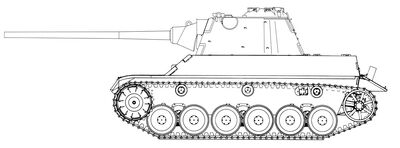
Sturmgeschütz III with 7,5cm StuG lg.K. L/30[]
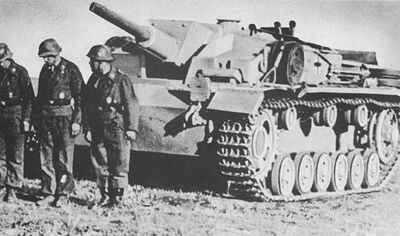
As early as July 1943, in War Department Intelligence Bulletin Volume 1 Number 11, what is likely a StuH 42 is misidentified as a StuG. The novel feature mentioned in the bulletin was the emergence of a third model of StuG, one armed with a 7,5cm L/30 cannon (The other two being armed with an L/23.5, in reality L/24, and L/43 cannon respectvely.) This L/30 gun was presumed to be a replacement for the older L/24 model.
From there, the origin of the myth can be traced to the "Catalog Of Enemy Ordnance Materiel", published in 1945 by the United States Chief of Ordnance, this was a simple misidentification of a Sturmhaubitze 42 Ausf.F with the muzzle brake removed. The confusion probably came from the fact that the StuH 42 and StuG III were nearly identical, except for the fact that the Sturmhaubitze had a 10,5cm gun, not a 7,5cm; so when US Intelligence got their hands on photos of StuG IIIs with longer guns than the early 7,5cm KwK 37 L/24, and shorter than the later 7,5cm KwK 40 L/43, they put two and two together and guestimated this was a interim gun, 87 inches long (7,5cm x L/30 = ~87 inches).
This mistake was further perpetuated in when author Steve Clayton wrote a piece for AFV News magazine, Volume 13, Number 2, from March 1978, detailing the discovery of a supposed "StuG III Ausf.L/33". The evidence for this vehicle was two photographs of three indivual tanks of Sturmgeschütz Brigade 280. Clayton posits that in the time between the KwK 37 L/24 being the main AFV support gun mounted on German tanks, and the time the KwK 40 L/43 came along, that there must have been one of the interim designs Krupp and Rheinmetall-Borsig were working on that was mounted on the StuG III in small numbers, and that that was the vehicle seen in these photos. In the subsequent May issue of AFV News (Volume 13, Number 3), reader Richard C. Harley of Scotland wrote in to express his doubt about the assumptions made in the article. Richard Harley correctly identified the vehicle as a StuH 42 Ausf.F without a muzzle break.
In the Volume 13, Number 6 issue of AFV News from November 1978, Mr. Clayton included an addendum, citing the Catalog Of Enemy Ordnance Materiel and German Tanks of World War II: The Complete Illustrated History of German Armoured Fighting Vehicles, 1926-1945 by Ferdinand Maria von Senger und Etterlin, which was based on the Catalog Of Enemy Ordnance Materiel, as proof that there must be an interim model gun that came between the L/24 and L/43. He goes on to question why the original Ordnance document describes the gun as a sturmkannone with an L/30 barrel length, while von Senger und Etterlin describes it as a kampfwagenkannone with a length of L/33. Clayton insists that the Ordnance manual must have made a mistake, and that this gun must have a barrel length of L/33. Also in the same issue, John E. Stauffer of San Diego wrote in to again dispute the idea of a StuG III L/33. He theorizes that there may have been confusion between the StuG III and the Sturm-Infanterigeschütz 33B. Mr. Stauffer also correctly identifies the vehicles in question as early StuH 42s.
Panther II with Schmalturm and 8,8cm KwK 43 L/71[]
While writing Der Panzerkampfwagen Panther und Seine Abarten, Walter Spielberger encountered a report dated from February 10th, 1943, stating that experience on the Eastern Front had shown that the Panther did not have sufficiently thick side armor. As the Panther had not gone into combat at that time, he assumed the date was a typo, and that the document was from 1944. However, the document was indeed from 1943, and was referring to problems experienced with other vehicles, mainly that Russian 14.5mm anti-tank rifles could penetrate their side armor. Since Spielberger had assumed this document came from 1944, not 1943, this led him to believe that the Panther II project was still going in 1944, even though it had thought to have been cancelled. This further led to the Panther II erroneously being linked with the Schmalturm turret (1944), and the Schmalturm mit 8,8cm KwK 43 L/71 (1945). In reality the Panther II was cancelled in 1943, since its major improvement - thicker side armor to defeat Russian AT rifles - was rendered redundant with the introduction of Schürzen.
Gefechtsaufklärer E-10 Leopard[]
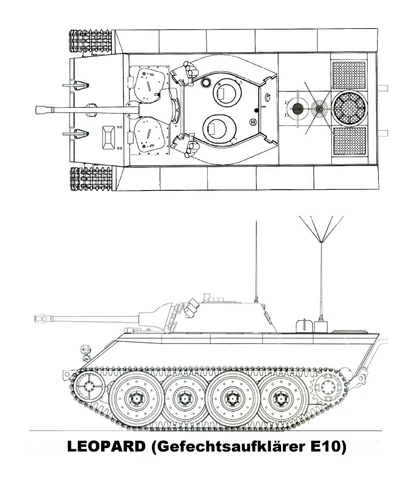
Made up by a Mr. Sebastian Nast; in what he claims is "historical extrapolation", had the War continued, this vehicle would have hit the battlefields in 1947. It is simply an E-10 chassis with a Gefechtsaufklärer Leopard (VK16.02) turret.
While a similar vehicle was proposed in the last days of the War (Panzer-Aufklärer auf E-25), the E-10 Leopard is not based in reality.
E-15[]
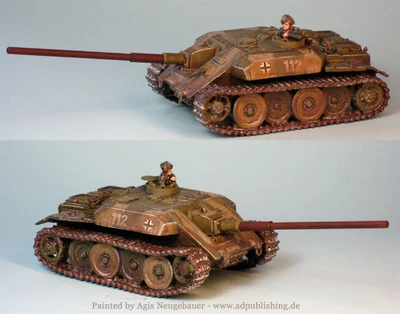
Originally a 1:72nd scale model coming from the now-defunct "World at Arms" site, then hosted at the site "adpublishing.de", this most has been reposed several times across different wargaming forums. The image is often often accompanied by the description from adpublishing.de, which notes it as a fictional "what if" vehicle, and describes it as an E-10 without hydraulic suspension, thicker armor, and an 8,8cm KwK 36 L/56 cannon. While "what if" vehicles are fine as long as they are marked as such, careless posters or careless readers might take it as a real design.
Panzerjägerwagen E-25 Jaguar II (E-25 with 8,8cm)[]
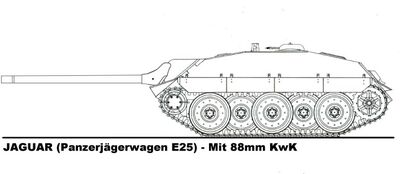
Made up by a Mr. Sebastian Nast; in what he claims is "historical extrapolation", had the War continued, this vehicle would have hit the battlefields in 1947. It is an E-25 with a 8,8cm PaK 43 L/71 cannon which Nast calls "Jaguar II", what "Jaguar I" was, he never says.
Due to the E-25's compact form, any gun bigger than the 7,5cm PaK 42 L/70 it was supposed to be armed with would almost certainly not have been able to fit into the tank.
Panzerkampfwagen E-79 Schwarzwolf / Zekke VK6600(h) (aka Panther III)[]
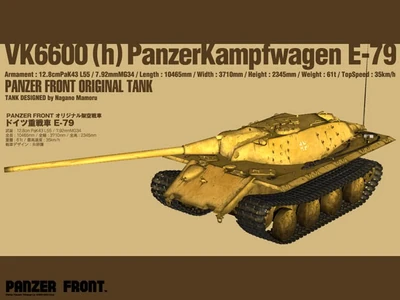
One of three fake German tanks made for the 1999 Playstation 1/Dreamcast game "Panzer Front". The motivation for the creation of these vehicles is still a mystery, as the game was supposed to be a "simulator". In the game the tank is called "Panzerkampfwagen VK6600(h) E-79", which in itself does not make sense; E-79 would imply it would weigh over 79 tons, but VK6600 would imply it to be in the 66 ton class. Even the nomenclature "VK6600" is wrong, VK numbers do not end in 0, they end in 1, 2, 3, and so on, for variations of that tank. For example, VK45.01, VK45.02, and VK45.03.
The names "Schwarzwolf" (Black Wolf) and "Zekke" were not from the game Panzer Front, but have since popped up on the internet, as has the name "Panther III". On many dubious websites and forum posts made by uninformed people, the E-79 is passed off as a real vehicle from the end of World War II, often with a convincing story about its supposed developement. However even those who do not have a great interest in the history of vehicles they model or play now recognize the E-79 as fake, and know its real story. The E-79 is probably one of the oldest and most known fake tanks.
Panzerjägerwagen E-79-128 (aka Jagdpanther III)[]
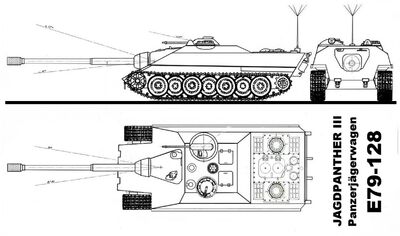
Made up by a Mr. Sebastian Nast, this is a tank destroyer based on the E-79 (see above). In what he claims is "historical extrapolation", had the War continued, this vehicle would have hit the battlefields in 1948 (nevermind the fact that the vehicle it's based on is from 1999). The name "Panzerjägerwagen" was never used in reference to a real vehicle. Had this vehicle been real, its name would have been "Jagdpanzer" or "Panzerjäger", depending on its purpose. Likewise it was not German nomecleture to use a dash and a number to denote gun calibre, expecially when there was no other alternative; something Nast has not made up at this time.
Schnell Jagdpanzer SchK I Aureole/75[]
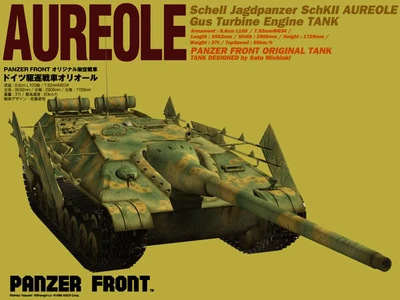
One of three fake German tanks made for the 1999 Playstation 1/Dreamcast game "Panzer Front". The name "Schnell Jagdpanzer" means "Fast tank destroyer", however the meaning of "SchK" is unclear. Possibly it stands for "Schnellkannone". "Aureole" is a French word meaning "halo". The most ridiculous thing about the Aureole's is that they were powered by twin jet turbines that shot flames out of the back. While turbine-powered tanks were something the Germans looked into (see Panzerkampfwagen Panther GT 101), the turbine would have been significantly down-tuned in order to power such a heavy vehicle.
Schnell Jagdpanzer SchK II Aureole/88[]
One of three fake German tanks made for the 1999 Playstation 1/Dreamcast game "Panzer Front". It differed from the Aureole/75 only in that the Aureole/88 had an 8,8cm KwK L/100 cannon.
Jagdpanther II[]
WIP
Jagdpanzer E-50 / Panzerjägerwagen E-50 (aka Falke)[]
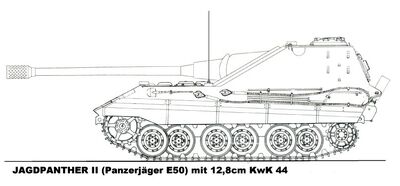
WIP
Jagdpanzer E-75[]
WIP
E-90 / Tiger III L[]
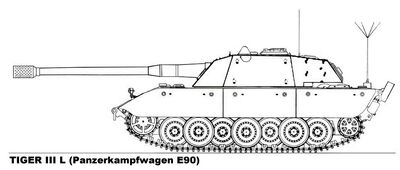
Originally made up by a Mr. Sebastian Nast, the E-90 has since passed into infamy among tank aficionados. In what he claims is "historical extrapolation", Nast says had the War continued, this vehicle would have hit the battlefields in 1947. It is a slightly scaled-down E-100 with a turret similar to the "E-100 Adler Turret" (also a fake: see a few entries down) presented as a "lighter alternative to the E-100."
The E-90, probably the oldest of Nast's creations, has taken on a life of its own on the internet since its inception. Users of various forums, most commonly the "World of Tanks Forums", will time to time start threads relating to the E-90 or vehicles like it. These threads are usually accompanied by either a fake history of the vehicle, or the user saying something along the lines of "I just found this, there isn't much about it, isn't it cool?"
At this time, most people who are even remotely serious about tank history now recognize the E-90 to be fake. Those that perpetuate the myth are usually new to the subject.
Jagdpanzer E-90 Krokodil / Panzerjägerwagen E-90 / Jagdtiger II / Kampfwagenvernichter E-90 Krokodile[]
WIP

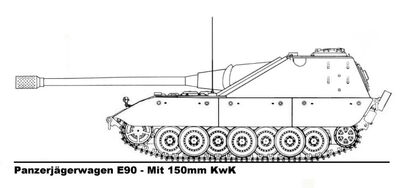
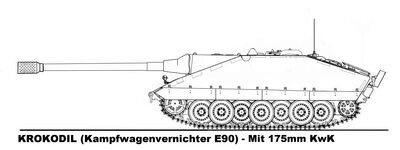
E-100 Henschel Turret / E-100 Ausf.B / Tiger III S[]
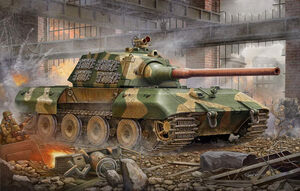
Created by the modeller Michael Rinaldi as a scratchbuilding exercise for a bit of fun. Using the 1:35th scale Dragon E-100 kit as a base, he cut down the turret and fabricated a new cannon barrel from a felt-tip pen. He called it the E-100 Ausf.B and the name stuck.
Soon enough, a story emerged on the internet saying that this was a seperate turret designed by Henschel that would've gone on the E-100 when it was finished. In reality, Henschel didn't design turrets. Henschel produced tank hulls while Porsche and Krupp made turrets. Had the E-100 been completed, it would've carried a Maus V2 or Maus II Turm.
Further perpetuating this myth, Trumpeter released a 1:35th scale model of the E-100 Ausf.B in 2008, calling it plainly "E-100". Why they used the fictional Henschel turret is unclear. In 2016 this was followed up by a 1:72nd scale version of the model.
In 2017 Trumpter released a retooled version of the model, now including the correct Maus II turret. On the webpage for the old 1:35th scale E-100 Trumpeter now acknowledges it is a hypothetical design, and calls it "E-100 Ausf.B". However this acknowledgement is not included on the page for the 1:72nd scale version, which is still in production as of 2017.
E-100 Adler Turret[]
WIP
Jagdpanzer E-100 Krokodil[]
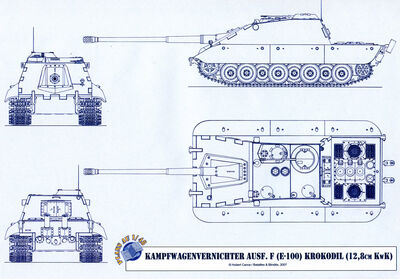
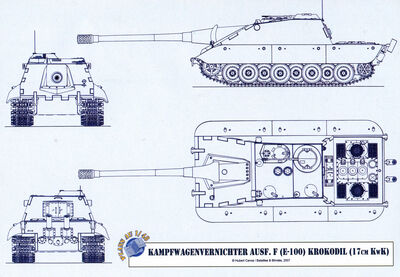
First appearing in November 2007 in the 22nd issue of Batailles & Blindés, a French historical magazine, the Krokodile remains the most widely circulated of all tanks on this page. The depictions of the vehicle were made by French artist Hubert Cance, on commission from Caractere (the publisher of Batailles & Blindés). How much influence, if any, Caractere had on the design is unknown.
Like all myths, there is a grain of truth to the Krokodil. Late in the war there was a proposal made for a heavy assault gun based on either the E-100 or Maus. This vehicle would have been armed with either a 15cm or 17cm cannon; likely the 17cm would have been chosen because Hitler preferred it. This vehicle, the Sturmgeschütz E-100, would have had a casemate placed in the middle or rear of the vehicle in order to distribute the weight evenly, and to prevent the gun from hanging over the front and making the vehicle unable to traverse slopes or woodlands; the same problem encountered by the Soviets in developing the ISU-152-2.
Cance produced two designs of the Krokodil, one with a 15cm cannon and the other with a 17cm. Both had a Jagdpanther-style forward mounted casemate. The placement of the casemate is the main problem with the Krokodil; the E-100's suspension could not have handled the weight of all that armor plus a 15cm (or 17cm!) cannon over the front coil springs. However, what really thrust the Krokodil into the spotlight was when Trumpeter came out with a 1:35th scale model of it in 2011. Trumpeter never called their Jagdpanzer E-100 "Krokodile", though their website calls the vehicle "Salamander" and even claims that prototypes were built! In 2016 Trumpter debuted a 1:72nd scale model of the Krokodile.
In 2017 Trumpeter retooled the kit, now calling it StuG E-100 rather than Jagdpanzer E-100. The new version of the kit has the casemate at the rear, and even seems to include the correct gun mounting - the only surviving piece of design for the original Sturmgeschütz E-100/Maus. While Trumpeter's 1:35th scale kit is now an acurate representation of the Sturmgeschütz E-100, the 1:72nd scale kit is still that of the Krokodil as of 2017. Nevertheless the seed has been sown; the Krokodil myth continues to be perpetuated on forums and less reputable websites. For whatever reason, while similar fakes like the E-79 and E-90 are generally recognized as fake, many people still believe the Krokodile was real. Unfortunately this 'flagship of fakery' lives on; showing just how undying false information can be.
E-100 Jagdtiger[]
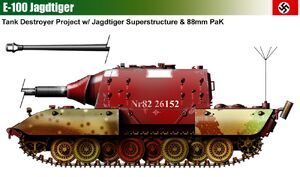
This tank was made up by wardrawings.be.
Flakpanzer E-50[]
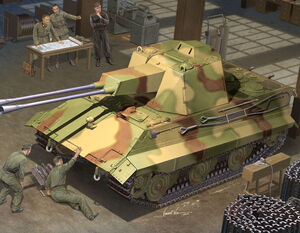
The Flakpanzer E-50 originated from the modeling company Trumpeter in 2010, when a 1:35th scale model kit of it was released. Trumpeter's source and motivation for making the design are unknown. The kit's description is as follows: "On May 8th 1944 the general of Flak-weapons ordered the development of a 5.5cm Flakpanzer with a Zwillingsflak (twingun). The twinguns should be integrated in a turret. Krupp and Rheinmetall got the order for the development of that turret. The turret was designed for the E-50/E-75 tank had a crew of 4 and 104 shot ammunition. A prototype of the turret had been build until January 1945."
The date and order for this gun, 5.5cm Flakzwilling Gerät 58, may very well be correct; actual documentation for this weapon system is virtually nonexistant. However Trumpeter's mistake was in assuming it was meant for the E series. In reality the Gerät 58 was projected to be mounted on the Panther chassis.
It is possible, had the War continued and the Gerät 58 and E-50 been produced, that they would have been combined into a "Flakpanzer E-50" as the Panther was phased out of production; but that is just conjecture.
Flakpanzer E-75[]
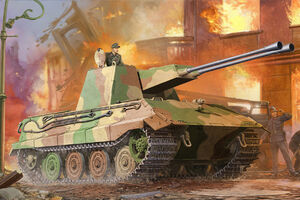
The Flakpanzer E-75 originated from the modeling company Trumpeter in 2010, when a 1:35th scale model kit of it was released. Trumpeter's source and motivation for making the design are unknown. The kit's description is as follows: "On May 8th 1944 the general of Flak-weapons ordered the development of a 5.5cm Flakpanzer with a Zwillingsflak (twingun). The twinguns should be integrated in a turret. Krupp and Rheinmetall got the order for the development of that turret. The turret was designed for the E-50/E-75 tank had a crew of 4 and 104 shot ammunition. A prototype of the turret had been build until January 1945."
The date and order for this gun, 5.5cm Flakzwilling Gerät 58, may very well be correct; actual documentation for this weapon system is virtually nonexistant. However Trumpeter's mistake was in assuming it was meant for the E series. In reality the Gerät 58 was projected to be mounted on the Panther chassis.
Unlike the Flakpanzer E-50, which in theory might have become real had the War continued, the Flakpanzer E-75 would never have materialized. The Panther chassis was used for the Gerät 58 because of its size and therefore ability to carry the weapon, not for its armor. The 80mm of frontal armor supplied by the Panther and by extention the E-50 was more than enough for a self-propelled anti-aircraft gun; the 150mm of frontal armor of the E-75, inherited from the Tiger II, would have been entirely unnecessary for a vehicle designed to fight enemies that would rarely fire back, and when they did - with at most 20mm autocannons.
Flakpanzer E-100 / Universalabwehrkampfwagen E-100UA Alligator[]
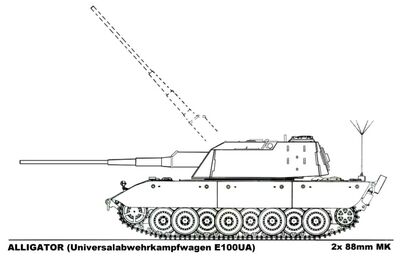
WIP
Flakpanzer Maus[]
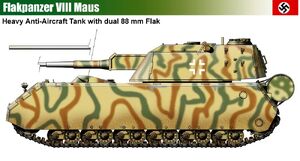
WIP
Geschützwagen Tiger P[]
This tank was made up by company WarGaming for their game World of Tanks. Possibly misinterpreted from the project to arm a Ferdinand with a captured French 210mm mortar (this project later led to the Sturmtiger) as an artillery piece.
Geschützwagen E-100[]
This was a scale model project from Sebastian Nast combining the E-100 model from Dragon with the PRECISION-Models 24cm K4 Sf gun and called it "Geschützwagen LÖWE auf Basis E-100"
the model was later used by Wargaming as base for the Tier 10 Artillery in World of Tanks
Waffenträger E-100[]
This tank was made up by company WarGaming for their game World of Tanks, and is a combination of a modified E-100 hull and 15cm Autoloading Anti-Aircraft Gun. It is worthy of note that the autoloading system was twice as big as is represented on WarGaming's vehicle. This fake was recently removed from the game.
Sturmmörser Maus[]
There was never a plan to design and produce a Maus with a 380mm mortar like the Sturmtiger.
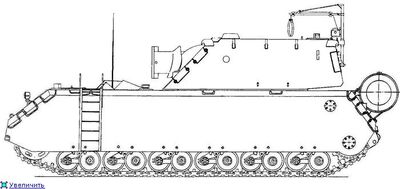
VK28.01(DB)[]
Supposedly a continuation of the Gefechtsaufklärer Leopard (VK16.02) project, this tank is mentioned vaguely on some unreputable websites as a larger version of the Leopard. The very concept of it makes no sense. The Leopard project was dropped because it was seen as not being worth the time to put into production an entirely new type of tank, that wouldn't be all that different from the Panther. Instead the Leopard was dropped and the Aufklärungspanzer V Panther took its place as the Wehrmacht's future scout tank. Why then, would a leopard with its hull lengthened to the size of a Panther, even be considered? It is oxymoronic! This tank would be identical to the Aufklärungspanzer V Panther, except that it wouldn't be based on an existing chassis, therefore it would need a separate production line, and a separate supply line to maintain.
VK72.01(K) (120 ton)[]
In mid-2013 WarGaming's World of Tanks video game debuted this vehicle as a special end-game reward, touting it as "A rear-turreted, 100 ton Löwe design." Immediately suspicions arose about the historical accuracy of such a design. WarGaming defended it as having coming from Walter J. Spielberger, a historian specializing in German World War II vehicles whose word often is regarded as law on the topic. This snippet from his book "Special Panzer Variants" was circulated to back up WarGaming's claim.
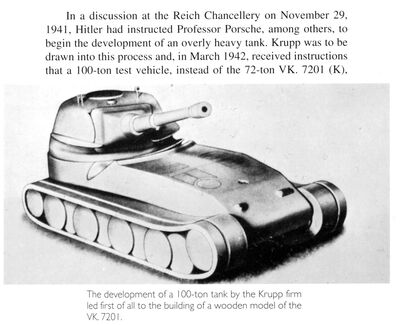
The excerpt from Special Panzer Variants.
Unfortunately, WarGaming's representation of the tank is where it all falls apart. In their game the vehicle weighs 120 tons and has 240mm thick frontal armor. As one can see by even briefly looking at the "source", the real VK72.01, which was one of many different Löwe designs, would have weighed 72 tons, as the name would suggest.
WarGaming's idea that the vehicle was over 100 tons comes from just a bit earlier in that same sentence, "[Krupp] received instructions that a 100-ton test vehicle, instead of the 72-ton VK72.01(K)... [was to be built]". The key word being "instead", which was ignored.
The 100 ton vehicle in question is the VK100.01, the vehicle which would later become the Maus. Much like the Löwe, the Maus project inflated massively in weight and armor over time. The VK72.01 was the last of the Löwe designs before the project was terminated and the Maus lineage was pursued instead.
The caption at the bottom of the picture, "The development of a 100-ton tank by the Krupp firm led first of all to the building of a wooden mockup of the VK72.01." was used as further grounds for the idea that the VK72.01 weighed 100 tons or more. What this caption is saying is that first of all in the development of the VK100.01, was the Löwe project, which ended with the wooden mockup for the VK72.01.
WarGaming "creatively" interpreted this unfortunately worded section of Spielberger's book in order to created a Löwe that is on par with the Maus. They used the wooden mockup as a basis for their model and assigned it arbitrary armor statistics in order to make it competitive for their game. At this point the story of this fake should end; unfortunately there is more.
I (the author) try to keep personal opinions out of articles on Panzerpedia and only present the facts, however for this vehicle I feel compelled to make an exception. If you the reader are only interested in the origins of this fake you can stop reading here; but for those of you who would like to see deeper into WarGaming's inner workings and the mindset of the people who are responsible for these fakes, this last paragraph is included.
The Fake Tanks page was one of the first pages on Panzerpedia, and still remains the most popular to this day. Orginally, instead of in depth histories of the origins of these fake vehicles, there were only single sentences to summarize each entry. Under VK72.01 I attributed its origin to the Russian historian Yuri Pasholok. There are two reasons for this, firstly Pasholok is WarGaming's in-house historical consultant, and second, he was very vocal in discussions of the VK72.01 and rejective of the notion it is fake. When this lowly website was brought to his attention he made several posts on his blog which reiterated the above misinterpretation as well as showed several original documents using the name VK72.01 as 'proof' that it was a real vehicle. I had never claimed the VK72.01 was not a real vehicle, but had asserted that the 120 ton tank that bears its name in World of Tanks is. Nevertheless, ignorance is common on the internet and if that was all it would not be worth including here. However in the three blog posts he made regarding the VK72.01 and several other fakes he had a hand in creating, he felt it was necessary to call me a "Polish fool" (for the record I am an American) and insinuate that I am stupid and illiterate. Now I am not saying this here because I have hurt feelings, I have been called much worse and frankly don't care what people call me; I am including this here so people may know that this is how WarGaming employees and Yuri Pasholok himself operate. I would advise anyone who is offered the opportunity to work with Pasholok to think heavily about if they really wanted to work with such an unprofessional man who has on numerous occasions displayed anti-Polish sentiment.
Schützenpanzerwagen E-50 Buffel[]
WIP
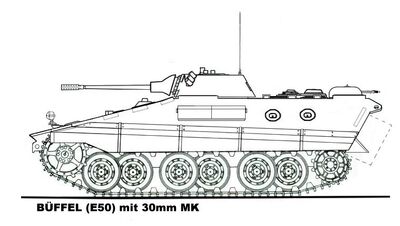
Sturmgeschütz T-34[]
The first photo was published in a magazine and passed off as real; the second photo is the original.
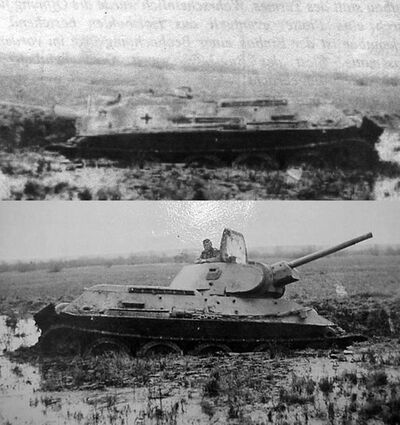
T-34 mit 8,8cm Flak 18[]
Original photo (left) was photoshopped to show a T-34 with a 8,8cm flak gun mounted on it. Furthermore, it would not make sense to mount a gun so high which would expose the tank.
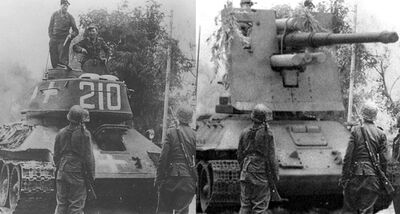
Various Photoshopped Pictures:[]
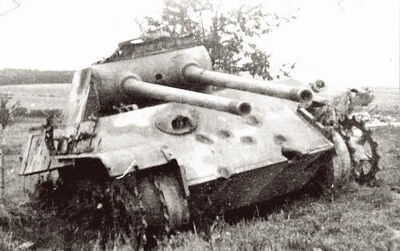
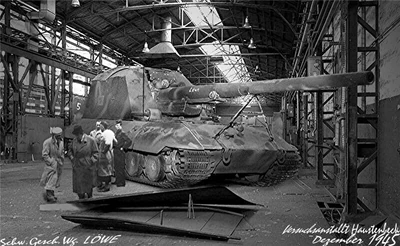
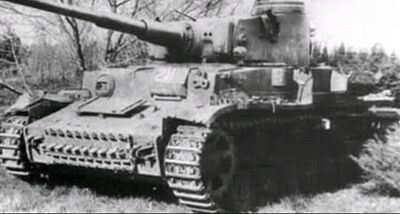
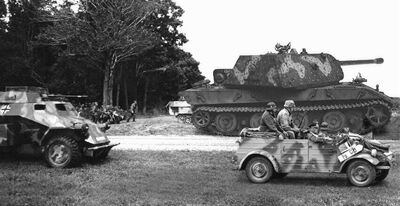
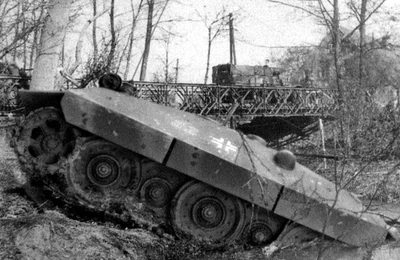
Jagdpanzer 38(t) photoshopped to look like an E-25